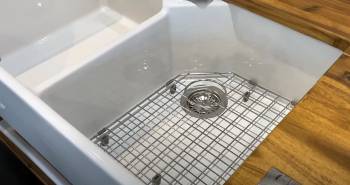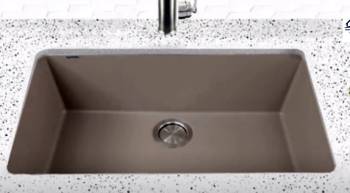When it comes to selecting the perfect sink for your kitchen, there are countless options available. But two popular contenders that have captured the hearts of many homeowners are fireclay and granite composite sinks.
In this comprehensive article, we’ll dive deep into the world of these two highly sought-after sink materials and help you decide which one is right for your kitchen.
A Brief Comparison Table
| Feature | Fireclay Sink | Granite Composite Sink |
| Aesthetics | Classic, timeless appeal | Sleek, modern appearance |
| Durability | Highly durable, resistant to scratches & stains | Highly durable, resistant to scratches & stains |
| Heat Resistance | High heat resistance | High heat resistance |
| Weight | Heavy, may require additional support | Heavy, may require additional support |
| Cost | Generally more expensive | Moderate to high cost |
| Color Options | Limited, mainly white | Wide variety of colors and patterns |
| Maintenance & Cleaning | Easy to clean and maintain | Easy to clean and maintain |
| Eco-friendliness | Made from natural materials | Made from a blend of natural & synthetic materials |
| Susceptibility to Chipping | Can chip if struck by a heavy object | Less prone to chipping compared to fireclay sinks |
| Fading & Discoloration | Not prone to fading or discoloration | Lower-quality sinks may fade or discolor over time |
The Story of Fireclay Sinks: A Timeless Classic
Fireclay sinks have been around for centuries, bringing a touch of timeless elegance to any kitchen. Made from a unique blend of clay and minerals, these sinks are fired at extremely high temperatures, resulting in a durable and nonporous surface. Let’s explore the advantages and disadvantages of fireclay sinks.
Pros of Fireclay Sinks

- Aesthetics
Fireclay sinks have a classic and timeless appeal that complements a wide range of kitchen styles, from traditional to modern.
- Durability
Due to the high-temperature firing process, fireclay sinks are highly resistant to scratches, stains, and extreme heat.
- Easy to Clean
The nonporous surface of fireclay sinks makes them easy to clean and maintain. A simple wipe down with a soft sponge and mild detergent is often enough to keep them looking pristine.
- Eco-friendly
Since fireclay is made from natural materials, it is an environmentally friendly choice for your kitchen.
Cons of Fireclay Sinks
- Weight
Fireclay sinks are quite heavy, which means they require additional support during installation. This can also make them more challenging to install.
- Cost
These sinks are generally more expensive than other sink materials, such as stainless steel or cast iron.
- Limited Color Options
Fireclay sinks are typically available in limited colors, with white being the most common. This can be a disadvantage if you’re looking for a specific color to match your kitchen design.
- Chipping
While fireclay sinks are highly durable, they can still chip if struck by a heavy object. Repairing chipped fireclay can be difficult and may require professional assistance.
The Tale of Granite Composite Sinks: A Modern Marvel

Granite composite sinks, on the other hand, are a more recent innovation. Made from a blend of natural granite stone and acrylic resins, these sinks offer the beauty and durability of natural stone combined with the easy maintenance of a synthetic material.
Let’s take a closer look at the pros and cons of granite composite sinks.
Pros of Granite Composite Sinks
- Aesthetics
Granite composite sinks have a sleek, modern appearance that can elevate the look of any kitchen.
- Durability
These sinks are incredibly durable and resistant to scratches, stains, and heat, making them an ideal choice for busy kitchens.
- Wide Color Range
Granite composite sinks come in a variety of colors and patterns, allowing you to find the perfect match for your kitchen design.
- Easy to Clean
Like fireclay sinks, granite composite sinks are easy to clean and maintain.
Cons of Granite Composite Sinks
- Weight
Similar to fireclay sinks, granite composite sinks are heavy and may require additional support during installation.
- Potential Fading
Some lower-quality granite composite sinks may fade or discolor over time, particularly when exposed to direct sunlight.
- Cost
While generally more affordable than fireclay sinks, granite composite sinks can still be pricey compared to other sink materials.
Frequently Asked Questions
The main downsides of fireclay sinks are their weight, cost, limited color options, and susceptibility to chipping. Due to their heaviness, fireclay sinks may require additional support during installation, and they can be more challenging to install than other sink materials.
Additionally, fireclay sinks are generally more expensive and come in fewer colors compared to other sink types. Finally, while fireclay is highly durable, it can still chip if struck by a heavy object.
Pros:
Aesthetically pleasing with a classic, timeless appeal
Highly durable and resistant to scratches, stains, and heat
Easy to clean and maintain
Eco-friendly, as they are made from natural materials
Cons:
Heavy, requiring additional support during installation
Generally more expensive than other sink materials
Limited color options, with white being the most common
Susceptible to chipping if struck by a heavy object
The main downsides of composite sinks are their weight, potential fading, and cost. Granite composite sinks can be heavy and may require additional support during installation. Some lower-quality composite sinks may fade or discolor over time, especially when exposed to direct sunlight.
Lastly, while generally more affordable than fireclay sinks, granite composite sinks can still be pricier compared to other sink materials.
Granite composite is considered the best composite material for kitchen sinks due to its combination of natural granite stone and acrylic resins. This blend results in a sink that offers the beauty and durability of natural stone along with the easy maintenance of a synthetic material.
Yes, you can pour boiling water into a granite composite sink without damaging it. Granite composite sinks are highly heat-resistant and can withstand temperatures of up to 536°F (280°C). However, it is always a good practice to use a sink protector or trivet to prevent potential thermal shock or damage to the sink’s surface.
High-quality granite composite sinks are highly durable and resistant to cracking. However, lower-quality composite sinks or sinks that have not been properly installed may be more susceptible to cracking.
It is essential to choose a reputable brand and follow the manufacturer’s installation instructions to ensure the longevity and performance of your granite composite sink.
Conclusion: Choosing Between Fireclay and Granite Composite Sinks
In the end, the choice between a fireclay sink and a granite composite sink comes down to personal preferences, budget, and kitchen design. Both sink materials have their unique set of pros and cons, making them suitable for different needs and styles.
Fireclay sinks are an excellent choice for those who value a classic, timeless appeal and appreciate the eco-friendly nature of the material. They offer durability, heat resistance, and easy maintenance, but can be more expensive and limited in color options.
On the other hand, granite composite sinks bring a sleek, modern aesthetic to the kitchen and offer an extensive range of colors and patterns to match various design schemes. They are also highly durable, resistant to heat, and easy to clean. However, they can still be pricey and may fade or discolor over time if not properly maintained or if made from lower-quality materials.
In conclusion, consider your kitchen’s overall design, your personal style, and the desired level of maintenance when making a decision. Whichever sink material you choose, make sure to invest in a high-quality product from a reputable manufacturer and follow proper installation and care guidelines to ensure the longevity and performance of your new kitchen sink.



